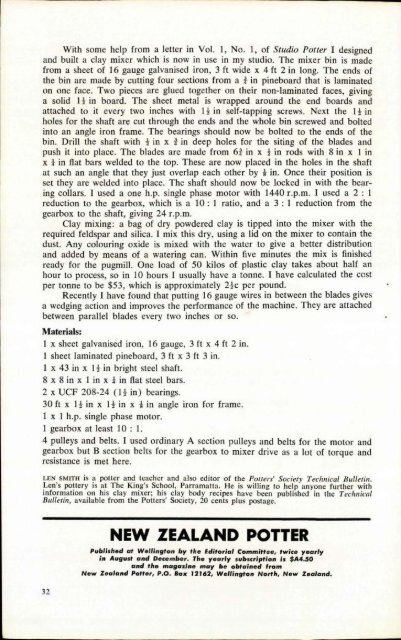Pottery in Australia Vol 17 No 1 Autumn 1978
Create successful ePaper yourself
Turn your PDF publications into a flip-book with our unique Google optimized e-Paper software.
With some help from a letter <strong>in</strong> <strong>Vol</strong>. I, <strong>No</strong>. 1, of Studio Potter I designed<br />
and built a clay mixer which is now <strong>in</strong> use <strong>in</strong> my studio. The mixer b<strong>in</strong> is made<br />
from a sheet of 16 gauge galvanised iron, 3 ft wide x 4 ft 2 <strong>in</strong> long. The ends of<br />
the b<strong>in</strong> are made by cutt<strong>in</strong>g four sections from a t<strong>in</strong> p<strong>in</strong>eboard that is lam<strong>in</strong>ated<br />
on one face. Two pieces are glued together on their non-lam<strong>in</strong>ated faces, giv<strong>in</strong>g<br />
a solid 1 t <strong>in</strong> board. The sheet metal is wrapped around the end boards and<br />
attached to it every two <strong>in</strong>ches with I t <strong>in</strong> self-tapp<strong>in</strong>g screws. Next the 1 t <strong>in</strong><br />
holes for the shaft are cut through the ends and the whole b<strong>in</strong> screwed and bolted<br />
<strong>in</strong>to an angIe iron frame. The bear<strong>in</strong>gs should now be bolted to the ends of the<br />
b<strong>in</strong> . Drill the shaft with t <strong>in</strong> x t <strong>in</strong> deep holes for the sit<strong>in</strong>g of the blades and<br />
push it <strong>in</strong>to place. The blades are made from 6t <strong>in</strong> x t <strong>in</strong> rods with 8 <strong>in</strong> x 1 <strong>in</strong><br />
x ! <strong>in</strong> flat bars welded to the top. These are now placed <strong>in</strong> the holes <strong>in</strong> the shaft<br />
at such an angle that they just overlap each other by t <strong>in</strong>. Once their position is<br />
set they are welded <strong>in</strong>to place. The shaft should now be locked <strong>in</strong> with the bear<strong>in</strong>g<br />
collars. I used a one h.p. s<strong>in</strong>gle phase motor with 1440 r.p.m. I used a 2 : I<br />
reduction to the gearbox, which is a 10 : 1 ratio, and a 3 : 1 reduction from the<br />
gearbox to the shaft, giv<strong>in</strong>g 24 Lp.m.<br />
Clay mix<strong>in</strong>g: a bag of dry powdered clay is tipped <strong>in</strong>to the mixer with the<br />
required feldspar and silica. I mix this dry, us<strong>in</strong>g a lid on the mixer to conta<strong>in</strong> the<br />
dust. Any colour<strong>in</strong>g oxide is mixed with the water to give a better distribution<br />
and added by means of a water<strong>in</strong>g can. With<strong>in</strong> five m<strong>in</strong>utes the mix is f<strong>in</strong>ished<br />
ready for the pugmill. One load of 50 kilos of plastic clay takes about half an<br />
hour to process, so <strong>in</strong> 10 hours I usually have a tonne. I have calculated the cost<br />
per tonne to be $53, which is approximately 2tc per pound.<br />
Recently I have found that putt<strong>in</strong>g 16 gauge wires <strong>in</strong> between the blades gives<br />
a wedg<strong>in</strong>g action and improves the performance of the mach<strong>in</strong>e. They are attached<br />
between parallel blades every two <strong>in</strong>ches or so.<br />
Materials:<br />
1 x sheet galvanised iron, 16 gauge, 3 ft x 4 ft 2 <strong>in</strong>.<br />
1 sheet lam<strong>in</strong>ated p<strong>in</strong>eboard, 3 ft x 3 ft 3 <strong>in</strong>.<br />
1 x 43 <strong>in</strong> x I t <strong>in</strong> bright steel shaft.<br />
8 x 8 <strong>in</strong> x 1 <strong>in</strong> x ! <strong>in</strong> flat steel bars.<br />
2 x UCF 208-24 (It <strong>in</strong>) bear<strong>in</strong>gs.<br />
30 ft x 1 t <strong>in</strong> x J t <strong>in</strong> x i <strong>in</strong> angle iron for frame.<br />
1 x J h.p. s<strong>in</strong>gle phase motor.<br />
1 gearbox at least 10 : I.<br />
4 pulleys and belts. I used ord<strong>in</strong>ary A section pulleys and belts for the motor and<br />
gearbox but B section belts for the gearbox to mixer drive as a lot of torque and<br />
resistance is met here.<br />
LEN SMITH is a potter and leacher and also editor of the Palters' Society Technical Bulletill.<br />
Len's pottery is at The K<strong>in</strong>g's School, Parramalla. He is will<strong>in</strong>g to help anyone furtber with<br />
<strong>in</strong>formation on his clay mixer; his clay body recipes have been published <strong>in</strong> tbe Technical<br />
Bullet<strong>in</strong>, available from the POllers' Society, 20 cents plus postage.<br />
32<br />
NEW ZEALAND POTTER<br />
Publishe d a t Well<strong>in</strong>gton by the Editorial Committe e , ,wice y e arly<br />
<strong>in</strong> August and De cember. Tlte yearly subscription is $ A4.50<br />
and ,lte magaz<strong>in</strong>e may b e obta<strong>in</strong>ed from<br />
New Ze aland Pot' e r, P.O. Box J2162, Well;n9fon <strong>No</strong>rth, Ne w Zealand.


















